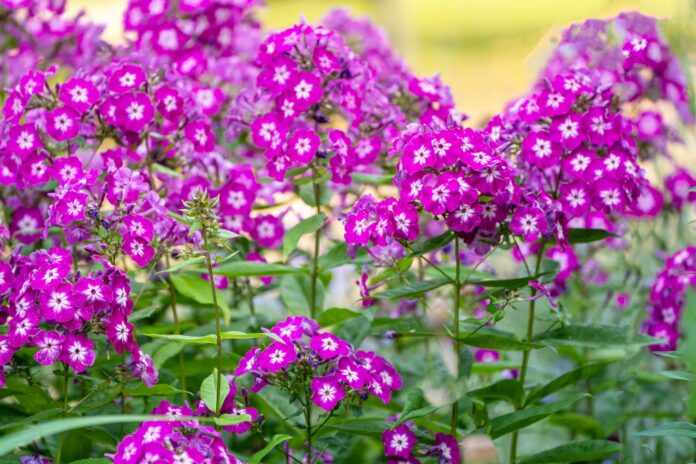Phlox is a captivating genus of flowering plants that brings vibrant color and life to gardens across the world. With its diverse range of species and varieties, it offers gardeners a plethora of options to enhance their outdoor spaces. In this guide, we’ll delve into the different types of it, their care requirements, and how you can maximize their beauty in your garden.
Understanding Phlox: Types and Varieties
Garden Phlox (Phlox paniculata)
Garden Phlox, or it paniculata, is a popular choice for gardeners due to its impressive blooms and hardy nature. It features tall, upright stems adorned with clusters of colorful flowers that can range from white to pink, red, and purple. Garden it typically blooms in mid to late summer, providing a burst of color when many other plants are starting to fade.
Characteristics:
- Height: 2 to 4 feet
- Flower Colors: White, pink, red, purple
- Bloom Time: Mid to late summer
Creeping Phlox (Phlox subulata)
Creeping Phlox, or it subulata, is known for its low-growing, spreading habit. This variety is ideal for ground cover, rock gardens, or cascading over the edges of containers. The small, colorful flowers bloom in early spring, creating a vibrant carpet of color that can last for several weeks.
Characteristics:
- Height: 6 to 12 inches
- Flower Colors: Pink, purple, white, red
- Bloom Time: Early spring
Phlox drummondii
Phlox drummondii, commonly known as Drummond it , is a striking annual that adds bold color to garden beds and containers. Unlike the perennial varieties, Drummond it offers a diverse array of hues, including vivid oranges, blues, and purples. This variety is particularly appreciated for its long flowering period.
Characteristics:
- Height: 1 to 2 feet
- Flower Colors: Orange, blue, purple, pink
- Bloom Time: Late spring to fall
Planting: Tips for Success
Selecting the Right Location
It plants thrive in a variety of settings, but they perform best in well-drained soil and full sun to partial shade. Garden it, in particular, benefits from a sunny spot where it can receive at least six hours of sunlight per day. Creeping it, being more versatile, can tolerate a range of light conditions but prefers some shade during the hottest part of the day.
Soil Requirements:
- Well-drained soil
- pH: 6.0 to 7.0 (neutral to slightly acidic)
- Organic matter enrichment
Preparing the Soil
Before planting, it’s crucial to prepare the soil to ensure your it plants have a healthy start. Work organic matter, such as compost or aged manure, into the soil to improve its structure and fertility. This will help retain moisture and provide essential nutrients for robust plant growth.
Soil Preparation Steps:
- Test the soil pH and adjust if necessary.
- Add organic matter to enrich the soil.
- Ensure proper drainage by avoiding areas with standing water.
Planting Phlox
When planting it, dig a hole that is slightly larger than the root ball of the plant. Space gardens it about 12 to 18 inches apart to allow for their mature size. For creeping it, space plants closer together to form a dense ground cover.
- Planting Steps:
- Dig a hole twice the width of the root ball.
- Place the plant in the hole at the same depth it was growing in its container.
- Fill in with soil and water thoroughly.
Caring Tips: Maintenance and Troubleshooting
Watering and Fertilizing
Phlox plants need consistent moisture, especially during dry periods. Water them regularly to keep the soil evenly moist, but avoid waterlogging. Over-watering can lead to root rot, so ensure good drainage. Apply a balanced fertilizer in early spring to encourage vigorous growth and abundant blooms.
Watering Tips:
- Water deeply and regularly, especially in dry spells.
- Avoid wetting the foliage to reduce the risk of fungal diseases.
Fertilizing Tips:
- Use a balanced, all-purpose fertilizer.
- Apply in early spring before new growth begins.
Pruning and Deadheading
Pruning phlox helps maintain its shape and promotes better air circulation. Remove spent blooms (deadheading) to encourage continuous flowering and prevent seed formation. Cut back the plants in late fall or early spring to remove dead stems and prepare them for the new growing season.
Pruning Tips:
- Deadhead regularly to prolong blooming.
- Cut back plants after flowering to maintain shape.
Pest and Disease Management
Phlox plants are generally resilient, but they can be susceptible to certain pests and diseases. Common issues include powdery mildew, aphids, and spider mites. To manage these problems, ensure good air circulation around the plants, avoid overhead watering, and use organic pest control methods when needed.
Disease Prevention Tips:
- Space plants improve airflow.
- Avoid overhead watering to reduce humidity around the foliage.
Enhancing Your Garden with Phlox
Phlox can be used in various ways to enhance your garden’s beauty. Combine different varieties to create stunning visual displays, or use creeping it to cover unattractive areas or slopes. it also makes excellent cut flowers, adding a splash of color to indoor arrangements.

Design Tips:
- Mix different phlox varieties for continuous blooms.
- Use creeping phlox as ground cover or in containers.
Cutting Tips:
- Harvest blooms early in the morning for best results.
- Change the water frequently to extend the vase’s life.
Conclusion
Phlox is a versatile and beautiful addition to any garden. By understanding the different types of phlox, their care requirements, and how to incorporate them into your landscape, you can enjoy their vibrant colors and lovely blooms throughout the growing season. Whether you’re planting garden phlox, creeping phlox, or Drummond Phlox, these tips will help you cultivate a thriving and stunning garden.



